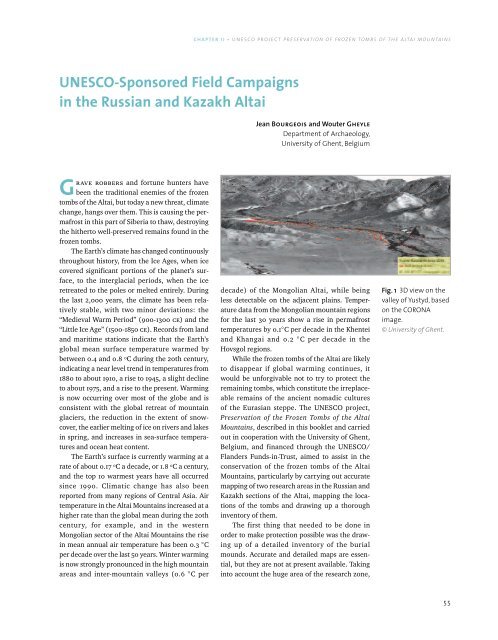Scythian Culture - Preservation of The Frozen Tombs of The Altai Mountains (UNESCO)
You also want an ePaper? Increase the reach of your titles
YUMPU automatically turns print PDFs into web optimized ePapers that Google loves.
CHAPTER II • <strong>UNESCO</strong> PROJECT PRESERVATION OF FROZEN TOMBS OF THE ALTAI MOUNTAINS<br />
<strong>UNESCO</strong>-Sponsored Field Campaigns<br />
in the Russian and Kazakh <strong>Altai</strong><br />
Jean Bourgeois and Wouter Gheyle<br />
Department <strong>of</strong> Archaeology,<br />
University <strong>of</strong> Ghent, Belgium<br />
Grave robbers and fortune hunters have<br />
been the traditional enemies <strong>of</strong> the frozen<br />
tombs <strong>of</strong> the <strong>Altai</strong>, but today a new threat, climate<br />
change, hangs over them. This is causing the permafrost<br />
in this part <strong>of</strong> Siberia to thaw, destroying<br />
the hitherto well-preserved remains found in the<br />
frozen tombs.<br />
<strong>The</strong> Earth’s climate has changed continuously<br />
throughout history, from the Ice Ages, when ice<br />
covered significant portions <strong>of</strong> the planet’s surface,<br />
to the interglacial periods, when the ice<br />
retreated to the poles or melted entirely. During<br />
the last 2,000 years, the climate has been relatively<br />
stable, with two minor deviations: the<br />
“Medieval Warm Period” (900-1300 ce) and the<br />
“Little Ice Age” (1500-1850 ce). Records from land<br />
and maritime stations indicate that the Earth’s<br />
global mean surface temperature warmed by<br />
between 0.4 and 0.8 ºC during the 20th century,<br />
indicating a near level trend in temperatures from<br />
1880 to about 1910, a rise to 1945, a slight decline<br />
to about 1975, and a rise to the present. Warming<br />
is now occurring over most <strong>of</strong> the globe and is<br />
consistent with the global retreat <strong>of</strong> mountain<br />
glaciers, the reduction in the extent <strong>of</strong> snowcover,<br />
the earlier melting <strong>of</strong> ice on rivers and lakes<br />
in spring, and increases in sea-surface temperatures<br />
and ocean heat content.<br />
<strong>The</strong> Earth’s surface is currently warming at a<br />
rate <strong>of</strong> about 0.17 ºC a decade, or 1.8 ºC a century,<br />
and the top 10 warmest years have all occurred<br />
since 1990. Climatic change has also been<br />
reported from many regions <strong>of</strong> Central Asia. Air<br />
temperature in the <strong>Altai</strong> <strong>Mountains</strong> increased at a<br />
higher rate than the global mean during the 20th<br />
century, for example, and in the western<br />
Mongolian sector <strong>of</strong> the <strong>Altai</strong> <strong>Mountains</strong> the rise<br />
in mean annual air temperature has been 0.3 °C<br />
per decade over the last 50 years. Winter warming<br />
is now strongly pronounced in the high mountain<br />
areas and inter-mountain valleys (0.6 °C per<br />
decade) <strong>of</strong> the Mongolian <strong>Altai</strong>, while being<br />
less detectable on the adjacent plains. Temperature<br />
data from the Mongolian mountain regions<br />
for the last 30 years show a rise in permafrost<br />
temperatures by 0.1°C per decade in the Khentei<br />
and Khangai and 0.2 °C per decade in the<br />
Hovsgol regions.<br />
While the frozen tombs <strong>of</strong> the <strong>Altai</strong> are likely<br />
to disappear if global warming continues, it<br />
would be unforgivable not to try to protect the<br />
remaining tombs, which constitute the irreplaceable<br />
remains <strong>of</strong> the ancient nomadic cultures<br />
<strong>of</strong> the Eurasian steppe. <strong>The</strong> <strong>UNESCO</strong> project,<br />
<strong>Preservation</strong> <strong>of</strong> the <strong>Frozen</strong> <strong>Tombs</strong> <strong>of</strong> the <strong>Altai</strong><br />
<strong>Mountains</strong>, described in this booklet and carried<br />
out in cooperation with the University <strong>of</strong> Ghent,<br />
Belgium, and financed through the <strong>UNESCO</strong>/<br />
Flanders Funds-in-Trust, aimed to assist in the<br />
conservation <strong>of</strong> the frozen tombs <strong>of</strong> the <strong>Altai</strong><br />
<strong>Mountains</strong>, particularly by carrying out accurate<br />
mapping <strong>of</strong> two research areas in the Russian and<br />
Kazakh sections <strong>of</strong> the <strong>Altai</strong>, mapping the locations<br />
<strong>of</strong> the tombs and drawing up a thorough<br />
inventory <strong>of</strong> them.<br />
<strong>The</strong> first thing that needed to be done in<br />
order to make protection possible was the drawing<br />
up <strong>of</strong> a detailed inventory <strong>of</strong> the burial<br />
mounds. Accurate and detailed maps are essential,<br />
but they are not at present available. Taking<br />
into account the huge area <strong>of</strong> the research zone,<br />
Fig. 1 3D view on the<br />
valley <strong>of</strong> Yustyd, based<br />
on the CORONA<br />
image.<br />
© University <strong>of</strong> Ghent.<br />
55
















